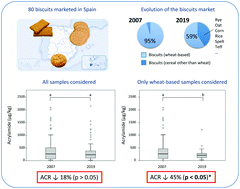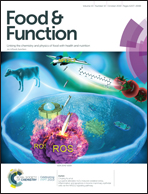Acrylamide in biscuits commercialised in Spain: a view of the Spanish market from 2007 to 2019
Abstract
The biscuit industry has evolved in the last decades with the inclusion of alternative cereals, pseudo-cereals and other ingredients in traditional recipes, which allows current consumers’ needs to be met. The dough composition, thermal treatment applied during baking, low moisture, and high rate of consumption make biscuits important contributors to daily exposure to acrylamide in Western diets. Acrylamide was determined by LC-ESI-MS/MS in 80 commercial biscuits marketed in Spain. The mean acrylamide content was 343 μg kg−1 (from <20 to 2144 μg kg−1). Rye, teff and oat-based biscuits exhibited the highest content (2144, 1559 and 1424 μg kg−1, respectively). 70% of the samples were below the benchmark level established by the EU Regulation 2017/2158. Compared to our previous prospective study in 2007 on the Spanish market, acrylamide has experienced an important decline (45%) in wheat-based formulations, demonstrating the effectiveness of the mitigation strategies applied in the sector. However, when all samples were considered, a slight non-significant decrease (18%) was observed. This fact suggests that the reformulation of traditional recipes with innovative cereals and ingredients could increase the acrylamide content in biscuits despite the mitigation strategies applied. Therefore, forthcoming reviews of the regulation should consider establishing categories in biscuits according to the main cereal, as has already been established in breakfast cereals.



 Please wait while we load your content...
Please wait while we load your content...